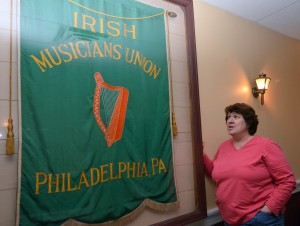Mary Lou McGurk’s memories of beloved Philadelphia Irish musician and radio host Tommy Moffit go back to when she was a little girl, dancing to his music at the Philadelphia Irish Center with the McDade School.
Later on in life, she got to know him better when he turned out to be good friends with her in-laws.
But probably the way McGurk knew Moffit best was in his role as one of the founders of the Philadelphia Ceili Group, the highly regarded organization dedicated to Irish traditional music and dance. McGurk, now president of the Ceili Group, has served as the stage manager for the group’s annual festival since 1980. Back then, and for many years almost until his death in 2010, the soft-spoken man from Roscommon was the festival’s amiable emcee. “We’d sit backstage between acts, and talk,” she says. “I knew him for a long time.”
Like many who knew Moffit, McGurk misses her old backstage pal. Happily, Moffit left behind something to remember him by.
Something really big.
It’s a green, gold-fringed banner with an ornate orange Celtic harp in the center—the standard of the old Irish Musicians Union of Philadelphia. Moffit was the last official president of the group, which held sway in the Irish musical community in the first half of the 20th Century. Moffit presented the banner to the Ceili Group about five years before his death.
“He just came to our board at that time, and he said, ‘I found this banner. Would you like to have it?’ We jumped at it.”
The banner, about three feet by five, would have been carried by members of the union in the Philadelphia St. Patrick’s Day Parade, McGur
k says. In those days, she adds, “everybody needed to be in the union—they wanted to be, of course. Ed Reavy, Tommy Caulfield, Ed Cahill … all of the old greats were in it.”
Because Moffit was the last president, McGurk says, he wound up with the banner.
The thin, delicate artifact is preserved in a large, weighty case, handmade by Ceili Group members Brian and Lorraine Quinn, McGurk says. The problem? Where to put it. “It’s just very large. It’s a wonderful gift but we didn’t know where to put it.”
Until relatively recently, the Ceili Group stored the banner in one of the cramped, dusty rooms next to the ballroom stage, where tables and chairs are stacked and stored. “It was in its case, but it was just leaning against the chairs,” she says.
And so it sat for several years, concealed from public view, McGurk says. “We kept saying, ‘What are we doing about it?’”
A couple of years ago, when the Irish Center refurbished its second floor, the Ceili Group was invited to hang the banner there. But that was no good, either, McGurk says. “We were angling for a spot, but it’s just too heavy for the walls upstairs, too.”
Opportunity came knocking about a year ago, when the Irish Center received a grant to install a new elevator leading from ground level on Emlen Street up to the second floor entrance to the ballroom. Along with the new elevator, the Irish Center refurbished the sitting room just off the elevator vestibule. Visitors who take the elevator have to pass through the sitting room to get to the ballroom. And there, front and center in the sitting room, hangs the delicate banner. It’s the first thing you see when you enter the room.
That spot, McGurk, seems “perfect.” Folklorist Mick Moloney was one of the first to see the banner when he was in town in November for a concert and lecture. McGurk recalls, “He looked at it and said, ‘This is an amazing piece of history. You’re lucky to have it.’”
History aside, the banner also serves as a reminder of the man who gave it. Whenever McGurk sees it, she thinks of him. “He was,” she says, “a wonderful, wonderful man.”


